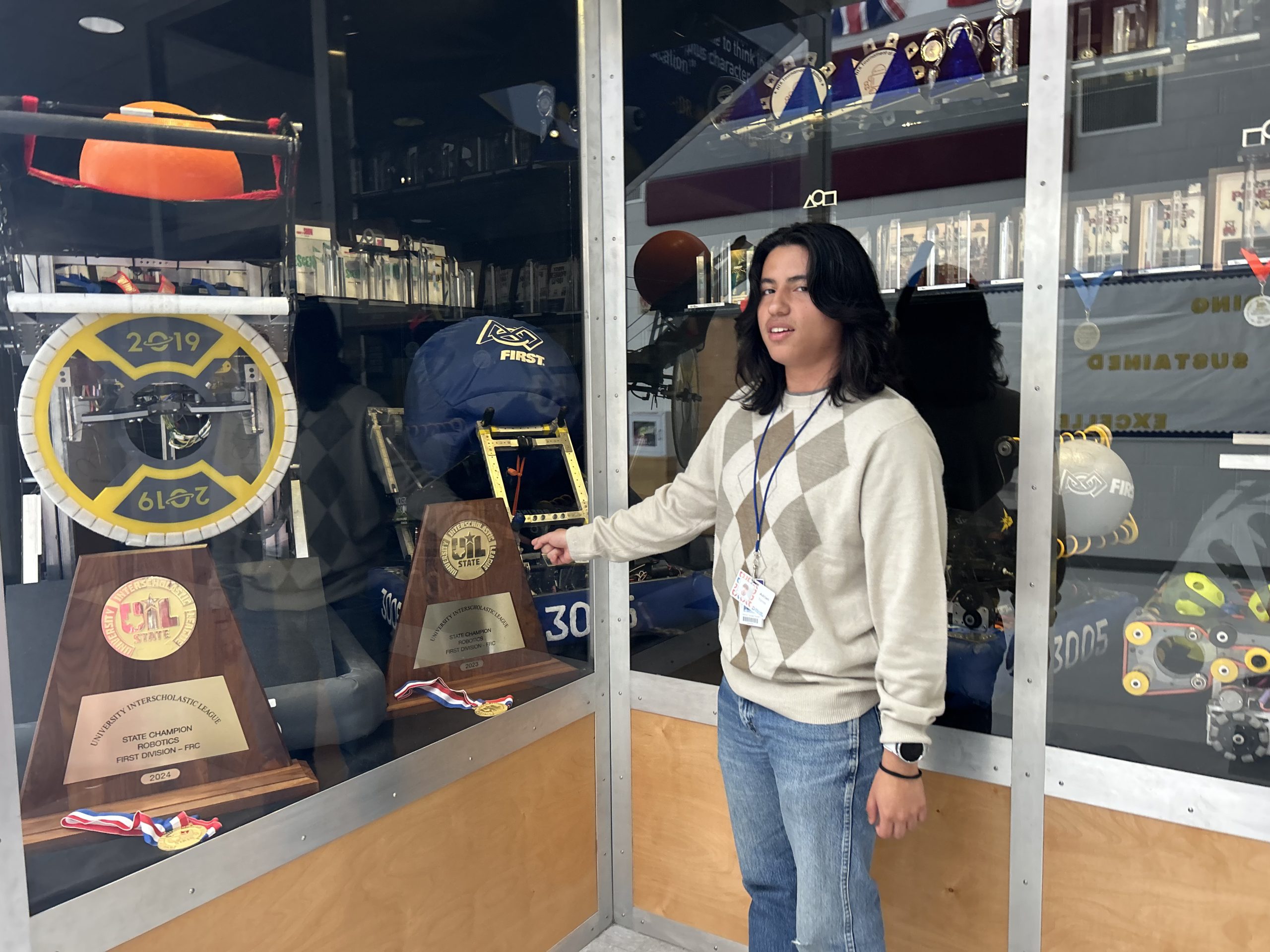
More first-generation students in Texas are applying for college
DALLAS — Adrian Torres’ obsession with race cars began when he was 11 years old. He got hooked watching a YouTube video of someone playing a Formula One game and quickly grew fascinated with the race cars themselves. In high school, he joined the robotics club.
“I’ve always wanted to learn how things work,” Torres said, and the robotics club taught him “that’s what mechanical engineering is.”
Going to college to pursue a degree in that field seemed like a good next step, but he had a lot to figure out. Neither his father, who is from Puerto Rico, nor his mother, who is from Guatemala, has a college degree. All they could do was encourage him.
With help from others, including mentors at the robotics club, Torres applied to college and is now a freshman at the University of Texas at Dallas. He’s part of a large wave of first-generation students applying to college in the state, one that has grown significantly over the last five years.
In recent years, Texas has received national attention for being one of the first states to ban all diversity, equity and inclusion programs in colleges and for ending in-state tuition rates for undocumented students. At the same time, the state has seen the number of first-generation college applicants more than triple in the last five years. Many of them are Hispanic.
After a 2023 state law banned DEI initiatives, providing tailored services to first-generation students became one of the few legal ways that colleges can offer special support to students from marginalized groups.
College enrollment dropped in the years after the pandemic amid worries from young people about high tuition rates, housing costs and student debt. But in Texas, the ranks of first-gen college applicants are steadily increasing because of concerted state efforts to get them to see college as an affordable possibility, experts say. The number of children living in households where the head of household has not earned a college degree has actually decreased slightly over the past five years, yet the number of high school graduates applying to college as the first in their families to do so has grown rapidly in Texas, from about 13,000 in the 2020-21 academic year to about 43,000 in the 2024-25 year, according to data from Common App, the nonprofit that offers a uniform application form used at more than 1,1000 colleges and universities.
The majority go on to enroll in college, according to advocates who help them with their applications.
“Absolutely we see more and more first-generation students who are trying to navigate this transition from high school into postsecondary over the last several years,” said Will Davies, director of policy and research at the nonprofit Breakthrough Central Texas, which helps these students do so.
Hispanic student enrollment, which is largely driving the boost in first-generation students, has increased in all but 10 of the 61 bachelor’s degree-granting public colleges in Texas since 2020, even as total enrollment fell for 46 of those institutions, according to federal data.

Related: Interested in more news about colleges and universities? Subscribe to our free biweekly higher education newsletter.
Advocates say the increase can be attributed partly to certain state-level policy decisions and investments over the past decade, including requiring students to complete the FAFSA to graduate from high school and offering free dual-enrollment college credits to high school students who qualify for free and reduced-price lunch. Also, college-access nonprofits like Breakthrough Central Texas and Education is Freedom have improved coordination among themselves to spread their efforts to more places, and many colleges have created better outreach programs.
“A lot of our first-generation students don’t know that college could be an affordable possibility because it’s not within the familial culture — their family has gone a different path,” said Susanna Russell, president and CEO of Education is Freedom. Her group has advisers embedded in low-income high schools in five school districts in the Dallas area, including the Dallas Independent School District, where Torres attended school and where about 1 in 5 children lives in poverty.
Davies noted that most first-gen applicants come from “working-class families facing real economic constraints.” In their college decisions, state political developments are less important than money issues.
“While students are aware of these developments — and they absolutely matter — affordability, financial stability, and navigating the complex college process remain the most immediate worries,” Davies said in an email. “Even though state and federal policies sometimes send signals that students like them don’t belong in higher education, what we see instead is remarkable determination and faith in the life-changing power of a college degree.”

Students often lack the help they need at their high schools, though: The ratio of Texas students to their counselors is 385 to 1, according to the most recent data. That’s why college access advocates from nonprofit organizations step in to help fill the gaps.
Advisers from Education is Freedom have a classroom in each high school they have partnered with that functions as the hub for all things college. Students often begin by asking for help creating an application or advice about financial aid, and as they get more excited about the possibility of college, they start to bring their friends.
Erin Balbuena, an adviser with Education is Freedom at South Garland High School, said many students think they don’t want to go to college because it will be just like high school, that they’ll have to be there from 7 a.m. to 2 p.m. every day. When Balbuena explains that the courses and scheduling are completely different, she said, “They’re like, ‘Wait, are you serious?’”
Some students have parents who are in the country without proper documentation and don’t file tax returns, in which case colleges often require them to fill out complicated income verification forms. If they’re in the country without their parents, that is even more difficult.
Even after they’ve received a college acceptance letter, first-generation students need guidance on next steps, said Nabil Naser, a manager with Education is Freedom who earlier worked as an adviser at Torres’ high school. They may not know they need to formally accept their financial aid offers or submit their final transcripts. Others don’t know that they should sign up for summer orientation before entering college. They may have trouble figuring out how to get the required meningitis vaccine.
If a student’s parents don’t know about the many steps the family needs to take even after the student is accepted, it’s difficult for them to advise their children about it.
Some of those students are undocumented, and for them the process of attending college has gone from difficult to nearly impossible. In June, the Texas attorney general’s office worked together with the Trump administration to make those students ineligible for in-state tuition at public colleges and universities — something that had been in place since the bipartisan Texas Dream Act passed in 2001. Those who had applied and were accepted to college this fall suddenly had to figure out how to pay their bills; many withdrew their acceptances.
Related: As colleges lose enrollment, some turn to a market that’s growing: Hispanic students
Texas has 36 nonprofits and community-based organizations that help students with college preparedness, according to the Coalition for College’s national registry of these groups. Over the past several years, leaders from these groups have pushed to better coordinate their efforts and be more efficient.
For example, in Dallas, Education is Freedom is part of a regional partnership with Dallas County Promise, a program that provides scholarship funding for students from low-income families.
In Austin, another group of nonprofits worked to create a data-sharing agreement with several local colleges. Scott Del Rossi, vice president of programs at a nonprofit called College Possible, said that with more information about students readily available to all, the groups can dedicate more time to supporting students and spend less time duplicating efforts to get information.
Colleges across the state are also increasingly reaching out to high schools to encourage students to enroll. Griselda Castilla, vice president for strategic enrollment at the University of Texas Rio Grande Valley, said her office sends campus representatives to local high schools to host not only information nights but also workshops for filling out complicated financial aid forms.

The university’s main campus is in a county where only 21 percent of adults have earned a bachelor’s degree or higher, far lower than the national average of 36 percent. Because the community is also overwhelmingly Hispanic, the university offers these resources in both English and Spanish.
The family orientation event is especially important, Castilla said, because “this might be the first time that mom and dad have ever set foot on a college campus.” It can prompt younger siblings or family members to start thinking about college early.
Nayeli Garza Ramos, a student at the University of North Texas at Dallas, said that her high school offered a class specifically to help students apply for college, but the information was only available in English, a language her parents can’t read or speak.
“It was so hard trying to figure out what forms I needed and then how to communicate to my parents what forms I needed them to give me,” she said. “And then as soon as they figured out what forms it was that I needed, then I had to go look for them, because they can’t read English, so it was such a mess. I had to figure out how to translate, even when I wasn’t sure what the correct translation was.”
Garza Ramos said she thinks the college application process will be a lot easier for her high school-aged brother because she will be able to help him with it.
Related: College Board cancels award program for high-performing Black and Latino students
First-generation college students often still need support when they get to campus, and when students see that they can get that support, it may encourage them to enroll — and stay. Texas colleges offer different types of support.

Some have created first-generation student centers that offer tutoring, help with navigating university bureaucracy and support in adjusting to life on campus. The University of North Texas and Texas Woman’s University, both in Denton, have such centers, where first-gen students can meet with advisers and peers.
At Texas Tech University in Lubbock, where about 1 in 3 undergraduate students is the first in their family to go to college, there’s a residential learning community specifically for first-generation students.
Mercedes Mascorro, a senior kinesiology student at Texas Tech who started getting support from the nonprofit Breakthrough Central Texas in sixth grade, chose to live in that community. She said students there felt familiar to her. She made friends and had access to free tutoring in the lobby of her dorm.
Even now, Mascorro said, she is in touch with her counselor from Breakthrough Central Texas, who has helped her fill out financial aid forms and find grants to help cover the costs of textbooks, she said.
Both the University of Texas Rio Grande Valley and the University of North Texas at Dallas have mentoring programs that designate older students as “trailblazers” for incoming students. At UTRGV, all freshmen are assigned a trailblazer mentor, said Cynthia Saldivar, director of student success initiatives there. Mentors help newcomers figure out how to use education management systems like Blackboard to submit assignments and how to decode terms like “co-requisite classes” or “bursar’s office.” The mentors also remind students when deadlines loom for things like financial aid applications or class registration.

Duane Williams, associate vice provost for student success and retention at Texas A&M University-San Antonio, said that roughly 70 percent of undergraduate students there are the first in their families to go to college, and many are also working to help support their families while in school.
His strategy, he said, is “inescapable engagement” — requiring support services for students. One example is a “pre-registration party” to help students complete all the things needed before they can register for classes. Every section of the required first-year seminar class blocks off a day to attend that event.
“As we know, students don’t do optional,” Williams said. “If that’s true, why make it optional?”
In Dallas, Adrian Torres is settling into the rhythm of his first semester of college. The dual enrollment classes he took in high school have allowed him to skip straight to classes he’s excited about, like introduction to engineering, calculus and chemistry.
He’s living with his family to save money, but to make sure he is involved on campus, he’s planning to join the Society of Automotive Engineers club, where he can make friends and work on building his own car and take it to competitions.
Eventually, he said he hopes to return to Conrad High School as a volunteer in the robotics club, where he can help first-generation students and aspiring engineers like himself see the opportunities out there for them.
Contact staff writer Olivia Sanchez at 212-678-8402 or osanchez@hechingerreport.org.
This story about first-generation college students was produced by The Hechinger Report, a nonprofit, independent news organization focused on inequality and innovation in education. Sign up for the Hechinger newsletter.
Source link



